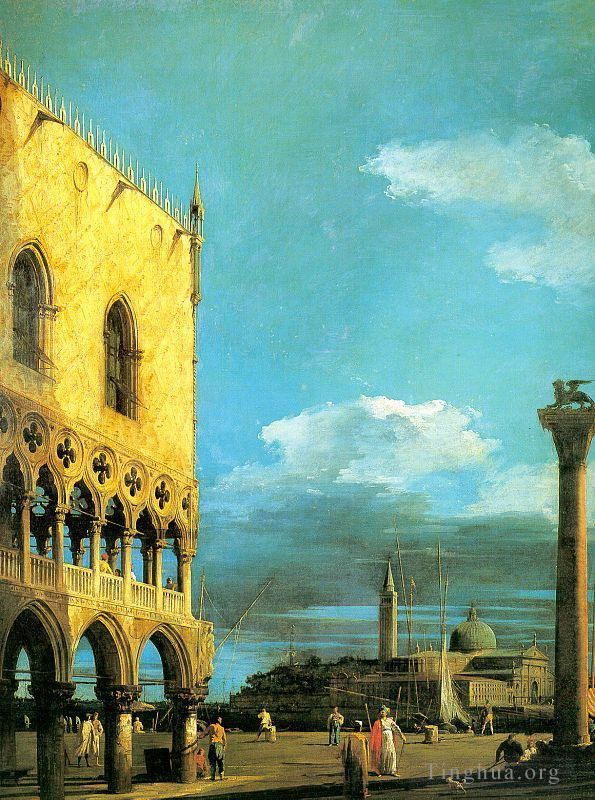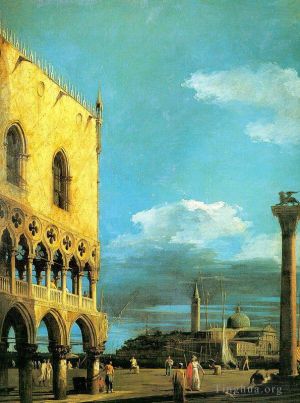The Piazzetta towards S. Giorgio Maggiore
Canaletto
- Price: Price on Request
- Art Type: Oil Painting
- Size:
- English Comments: 0
- International Comments: 0
- Creating Date:
- Introduction and Works of Canaletto >>
Work Overview
- The Piazzetta towards S. Giorgio Maggiore
Canaletto
Date: 1727; Venice, Italy *
Style: Baroque
Genre: cityscape
This painting is part of a set of six large views of the Piazza San Marco and the Piazzetta in the heart of Venice. The series may have been Canaletto’s earliest commission from Joseph Smith, who sold his pre-eminent collection of paintings, prints and drawings by the artist to George III in 1762. Each view in the set, comprising four of upright and two of horizontal format, has been carefully composed so that architecture dominates either the left of the view, as here, or the right. Sharp diagonals are emphasised by the deep shadows cast by evening light. The paintings were probably arranged symmetrically in a room in Smith’s residence on the Grand Canal, the Palazzo Balbi (now Palazzo Mangilli-Valmarana). A closely related preparatory drawing for each view (also in the Royal Collection) may have been the basis for discussion between artist and patron. The care taken over the composition of the architecture and the changes made during the course of painting suggest that the balance and effect of the whole was important to both of them.
The left corner of the Palazzo Ducale and the column of San Marco frame the church and campanile of San Giorgio Maggiore. The set of paintings must date before 1726-8 when the crowning element of the campanile (in the centre of the present view) was altered from conical to onion shape; in 1774 it was replaced by the one seen today. The fluid, broad strokes, particularly those defining the figures, the strong diagonals and contrasts of light, can be found in Canaletto’s view of The Stonemason’s Yard (London, National Gallery) which has been dated 1725. It is generally agreed that the set precedes both that painting and the series of four paintings commissioned by Stefano Conti (private collection), datable 1725-6.
Canaletto combines several viewpoints and distorts topography for dramatic effect. For example, San Giorgio is heightened; and from this viewpoint there should be one upper window in the Palazzo Ducale, not two. Mathematical instruments were used to establish the architecture: a straight edge ruled out the right side of the column and perspective lines on the Palazzo Ducale. In the preparatory drawings a beam and pulley projects from the loggia of the Palazzo, discernible as a pentiment in the final painting. The paintings appear to have arrived in London unframed; if so, this would strengthen the suggestion that they had been set into a room in one of Smith’s houses in Italy. George III framed them in English ‘Maratta’ frames when he hung them in the Entrance Hall of Buckingham House.
- Copyright Statement:
All the reproduction of any forms about this work unauthorized by Singing Palette including images, texts and so on will be deemed to be violating the Copyright Laws.
To cite this webpage, please link back here.
- >> English Comments
- >> Chinese Comments
- >> French Comments
- >> German Comments
- >>Report
- Capriccio with ruins and porta portello in padua
- The women s regaton the grand canal
- The campo di rialto
- The Eastern Facade Of Warwick Castle
- Riva degli Schiavoni west side
- The piazzetta towards san giorgio maggiore
- Doge Palace
- Santa Maria Zobenigo
- Grand Canal
- San Giacomo Di Rialto
- The Piazzetta
- Capriccio with classical ruins and buildings
- Grand Canal From Santa Maria Della Carita To The Bacino Di San Marco
- Basilica di vecenza and the ponte de rialto
- Capriccio of a round church with an elaborate gothic portico in a piazza a palladian piazza and 1755
- Piazza San Marco Venice (Piazza San Marco with the Basilica)
- The Nave of San Marco looking East (San Marco the Interior)
- Warwick castle
- The Bucintoro Returning To The Molo On Ascension Day
- A Regatta on the Grand Canal
- Venice Viewed from the San Giorgio Maggiore
- View of the Ducal Palace
- Piazza san marco looking east
- The Bacino di San Marco on Ascension Day
- View Of the Entrance To The Arsenal
- Dolo On The Brenta Venetian Venice
- The Molo Looking West
- Palazzo Ducale and the Piazza di San Marco
- Grand Canal The Rialto Bridge From The South
- Scala dei giganti 1765
- The Riva Degli Schiavoni
- Rio Dei Mendicanti
- The interior of henry vii chapel in westminster abbey
- View of the grand walk vauxhall gardens with the orchestra pavilion the organ house the turkish
- Perspective View with Portico
- Stonemasons Yard
- View of the Bacino di San Marco St Marks Basin
- Perspective with a portico 1765
- The thames with st pauls cathedral 1746
- Piazza San Marco 1730
- Reception Of The Ambassador In The Doges Palace
- Dolo on the brenta
- Return Of The Bucentoro To The Molo On Ascension Day
- The chapel of eton college 1747
- The Grand Canal From Rialto Toward The North
- The Grand Canal with the Rialto Bridge in the Background
- View Of Campo Santi Apostoli
- Perspective view with portico
- Capriccio of the grand canal with an imaginary rialto bridge and other buildings
- London Interior of the Rotunda at Ranelagh
- The Grand Canal looking East from Campo San Vio towards the Bacino
- The Fonteghetto Della Farina
- The Piazzetta towards S. Giorgio Maggiore
- The thames and the city of london from richmond house 1746
- Campo san rocco
- Night time celebration outside the church of san pietro di castello
- The Stonemasons Yard
- Canal Giovanni Antonio View Of The Grand Canal And Santa Maria Della Salute With Boats And Figure
- The Piazzetta towards Santa Maria della Salute
- Piazza San Marco The Clocktower
- Capriccio of a renaissance triumphal arch seen from the portico of a palace 1755
- Bacino di San Marco St Marks Basin
- San francesco della vigna church and campo
- Entrance To The Grand Canal Looking East
- Alnwick castle
- Piazza San Marco Looking Southeast
- Westminster abbey with a procession of knights of the bath 1749
- CANALETTO Grand Canal Looking Northeast From Palazo Balbi Toward The Rial to Bridge
- The Feast Day of St Roch
- Arrival of the French Ambassador in Venice
- CANALETTO Grand Canal Looking East From The Campo San Vio
- Capriccio Ruins And Classic Buildings
- The Entrance to the Grand Canal Venice
- A Regatta on the Grand Canal
- English Landscape Capriccio with a Column
- The dogana in Venice (Punta della Dogana in Venice)
- Santi Giovanni E Paolo And The Scuola Di San Marco 1726
- Campo santa maria formosa
- The Piazza San Marco in Venice
- San Cristoforo San Michele and Murano from the Fondamenta Nuove Venice
- The Grand Canal with Santa Maria della Salute looking East towards the Bacino
- Rome the arch of constantine 1742
- Santi Giovanni e Paolo and the Scuola de San Marco
- The Grand Canal near the Ponte di Rialto
- Venice Piazza San Marco and the Colonnade of the Procuratie Nuove









 Singing Palette
Singing Palette